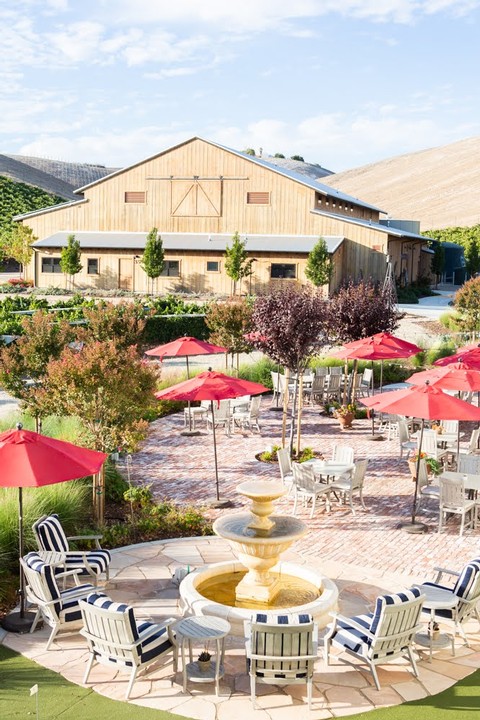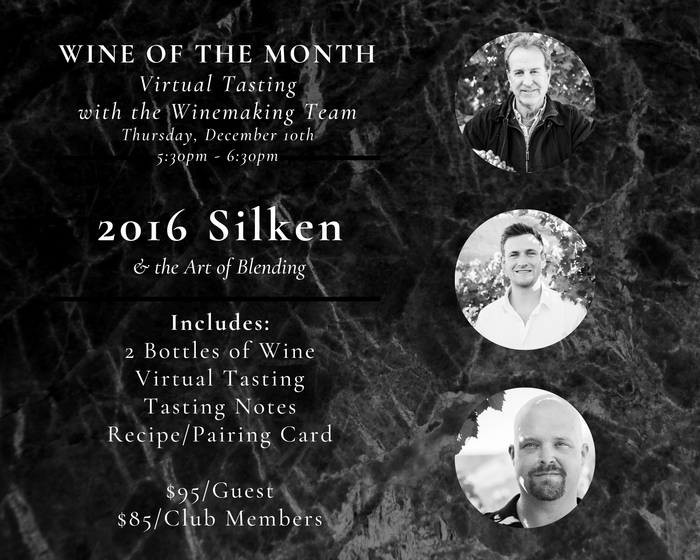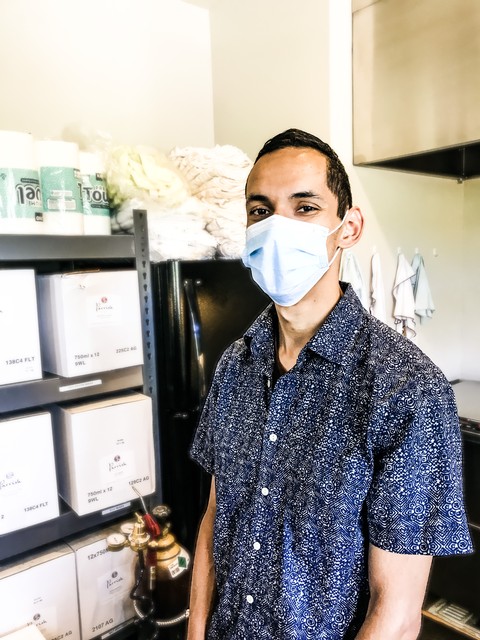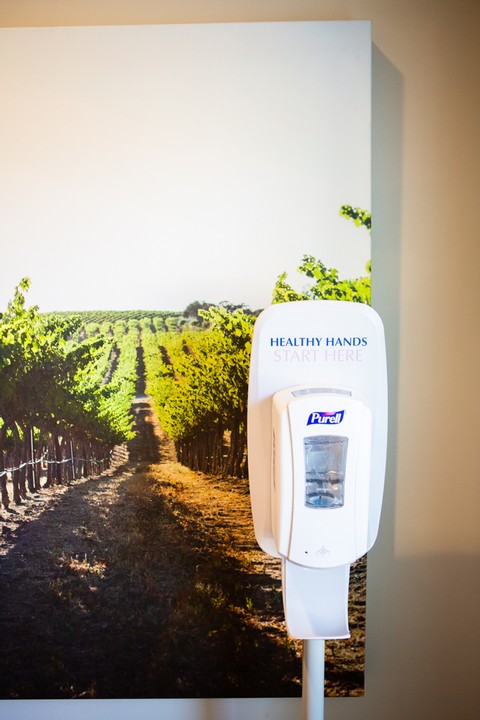Parrish Family Vineyard Blog
Keep up with the Parrish Family Vineyard!
Vines & Wines
Discover more about the Parrish vineyards & winery.
Wine & Food
Wine and food offerings and pairings.
Events
Learn more about upcoming Parrish events & specials!
Visit Paso Robles
Visiting Paso Robles soon? Learn of wineries, food, and lodging for your next trip to Paso Robles' wine country.
Winter in the Vineyard & A Quick Look at the Year
Winter is upon us with its calm and cold presence ushering in a quiet time for the vines. I have a lot of times called this their sleepy time, but in more formal words, the vines are currently dormant. It is a perfect time for dormancy as the temperatures can drop below 30 degrees. Even in Paso Robles, California we can get freezing temperatures at night and early mornings. So, dormancy protects the vineyard from being hurt by the freezing temperatures.
The vines have gone through senescence after the hard work of harvest, which is the dropping of leaves. Since the leaves are now covering the floor of the vineyard, it indicates that the vines have stopped photosynthesis (energy production). The vines don’t die because they have stopped photosynthesis, but rather they depend on the stored energy in their trunk and roots. This brings up one of the important practices for a vineyard and that is soil health. The soil is what provides nutrients to the vines. During this season we will work on the soil by applying fertilizer and/or planting cover crop seeds (i.e. flowers, vetch, or barley).
Shortly, we will also work on pruning the vines to prepare them for the growing season. With pruning, the prior year’s canes are cut back leaving the best canes for the new year’s shoots. There won’t be a lot of activity with the vines until bud break which usually occurs in April and marks the start of the growing season. Below I have dug up a timeline I made years ago of the stages of growth throughout the year highlighting the important moments for the vines. The months listed are approximate as every year is different due to the weather.
My hope this year is to share more information about the vineyard when they are happening, so we’ll see how I do!
Cheers!
Cecily Parrish Ray

Reflecting on 2020
It is December 31st, 2020. The last day of this year. Who would have foresaw during the joyous calls of "Happy New Year!" on January 1st, 2020 at 12am that this year would unfold the way it did. Normally we experience difficult times at different times, but in 2020 we experienced it at the same time. It has truly been a notable year for everyone that will be remembered.
It was a year that has brought about deep gratitude and togetherness despite what one would think. As I reflect on these photos and videos above, it amazes me to see such a year with vibrant life, colors, and joy. I believe the reason is that our family and team chose to make it that way. That is not to say that we haven’t had moments, but we chose to work hard together and keep going with the best attitudes possible. Thank you so much to them for all their hard work and team work. I truly could not have gotten through this year without them.
It was also a year of sharing with guests even though it was with distance and behind masks. There were so many moments and stories we got to experience with our members and guests that it brought us all closer. Thank you to all our club members and guests who trusted us to provide safe service. Thank you for the support and encouragement.
Lastly, it was a year of unexpected joy thanks to the location of our tasting room and winery. We saw the hills frame beautiful, inspiring sunsets. We had many visits from wild life from reptiles to birds…one we weren’t able to capture was a recent visit from a bobcat. It’s these moments that make us pause and remember that there is so much more to life than just the doom and gloom.
My heart is so full as I watch this video. Despite all the difficult and unimaginable, thank you God for such a year as this.
With a grateful heart,
Cecily Parrish Ray
Wine Pairings - Christmas Movies!

We were thinking that this is a perfect time for wine pairings with Christmas movies. Our family has always loved watching movies this time of year and there are a few that are tradition for Christmas Eve and Christmas Day. So here’s our list...
2018 Sauvignon Blanc – Rifftrax Christmas (Mystery Science Theater 3000 Fans)
2018 Chardonnay – The Santa Clause (1994)
2016 Petite Sirah – The Family Man (2000)
2016 Silken – While You Were Sleeping (1995)
2016 Four Chords – Christmas Carol (1951, traditionally on Christmas Eve)
2016 Estate Cabernet Sauvignon – Miracle on 34th Street (1947)
2016 Reserve Cabernet Sauvingon – It’s a Wonderful Life (1946, traditionally on Christmas Day)
Tomorrow is National Christmas Movie Marathon day, so grab a blanket, turn on the tree, and enjoy! We’re open 11am-5pm if you need some wine for this. Cheers!
Virtual Tastings!
Watch our two most recent Virtual Experience below. Enjoy our next virtual on December 10th featuring our 2016 Silken and our Winemaking Team! Tickets Here
Virtual Tasting with Petite Sirah
September 24th, 2020
Learn more about our 2016 Petite Sirah as well as other facts about the variety.
Also, a fun sensory experience of pairing spices with wine.
Hosts:
Erin Foley - Wine Club & Event Coordinator
Samantha Eitel - Estate Chef
Cecily Parrish Ray - General Manager
Virtual Tasting with Chardonnay
October 29th, 2020
Featuring our 2018 Chardonnay, learn about the variety as well as some wine nerd facts like ML.
The team also shares a paired cheese with the tasting group and how we pair with the wine.
Hosts:
Erin Foley - Wine Club & Event Coordinator
Lupita Sotelo - Tasting Room Manager
Samantha Eitel - Estate Chef
Cecily Parrish Ray - General Manager
Still Safely Open with Award of Excellence
Hello PFV Guests!
We received word (7/13/2020) that Govenor Newsom wants wine tasting experiences to continue outside only at this time. While we love our indoor space, we are blessed with spacious, beautiful outdoor areas giving us the ability to distance guests according to the guidelines. We have been following guidelines for our experiences upon reopening in late May with our team wearing masks and gloves to put your mind at ease during your visit. Our team, led by our Tasting Room Manager Lupita, also has been working hard to sanitinize surfaces through out the day. We have also been serving our delicious, fresh, comforting food by Estate Chef Samantha with plastic utensils and paper plates (the nicest we can find) as an extra precaution.
With all our effort, our team is happy to announce that late last week we were given an Award of Excellence by the San Luis Obispo County Environmental Health Services. We scored 100% on our routine inspection and passed in spades for the covid inspection. We are ready to continue serving you outside and are even looking into ways to cool our spaces during the Summer months (my dad is on it!). Thankfully we are looking at 80 degree weather this weekend!
If you are comfortable, we invite you to join us as we will continue to operate safely and we appreciate your patience as we work through this uncharted time together. Please feel free to visit our virtual tour, here, as it reflects the space we have (table distance has been modified since the video was shot).
Thank you to all who have supported us during this time. My family, my team are forever grateful to you.
Blessed,
Cecily Parrish Ray




Opening Thursday, May 28th - New Hours!
We are excited to share we are opening our doors on Thursday, May 28th for service! We have our current hours listed below in this email.
We have new wines and an entirely new food menu to share with you! You can review the food menu here. Our team has been working tirelessly the last few weeks in preparation for this moment. A huge thank you to them!
Regarding visiting, things are going to look a little different as we have guidelines set forth by our County in this 2nd Phase of re-opening. Things will change possibly in the future, so we appreciate your patience as we head into these uncharted waters together. Our top priority above all is your safety and the safety of our staff. We are following sanitizing and cleaning guidelines that have been set forth.
The following are important notes regarding your visit as these are inline with the County guidelines:
- Reservations are required for visits at this time. Reservations can be made here.
- Masks will be required while entering the tasting room and we can provide one if needed.
- All wine purchases must accompany a food order. We ask that there only be one check per table and that group sizes are limited to 10 people.
- Most seating will be outdoors. All tables are set at six feet apart to maintain proper social distancing, this includes our limited indoor seating.
We know that this will be an adjustment and again we appreciate your patience. We are beyond thrilled to have you visit and finally be able to enjoy our beautiful location, wines, and food!
Hours
Thursday-Sunday
11am-6pm
Reservations Required, but it's easy to make here!
White Flight Virtual Tasting with David and Vanessa
Ok, it's hot! Join Winemaker and owner David Parrish and Certified Sommelier Vanessa Igel as they taste through our white wines and chat pairings and movies.
Grab a glass of Sauvignon Blanc, Chardonnay and Rose to join along.
Click here for the video and here for more details about the wines they are tasting.
Easy Sourdough Starter + Tips
Sourghdough starters do sound challenging, but I hope to help make them more approachable as I was not born a bread baker. Starters are great for not only baking bread, but also cakes, cookies, and pasta. You can become your own bakery essentially, which is especially helpful being shut in. We have been making a Cabernet Sourdough since we opened in 2018. This starter was made from our Cabernet Sauvignon grapes, which you can read about on a previous blog post here. While I love our starter, it is not feasible for those at home wanting to start their own right now.
Two weeks ago I saw a starter recipe that looked really simple from Taste of Home and decided to try it a couple weeks ago. It went great, so without further ado I am going to share the recipe with a few tweaks, feeding info, and helpful starter info as I had a ton of questions when I started! Also, I will have a few tips if you are missing ingredients, or in need of a gluten free starter as everyone has different needs right now.
The Starter Recipe:
1 & ½ teaspoons (or a packet) of Yeast
2 Cups (11 oz) of Flour
2 Cups (16 oz) of Water at 70-75°F
Use a container like a large tupperware that you can put a lid on. Avoid a metal bowl for your starter as that will impact the temperature of your starter. You can use measuring spoons/cups or a digital scale. Digital scales tend to be more accurate. You will also need a thermometer to take the water temp.
*Yeast: Original recipe calls for Active Yeast. I used Instant Yeast and turned out just fine. Use what you have.
*Flour: The recipe calls for All Purpose (AP) Flour, but you could substitute for Bread Flour. Below I share the differences in flour.
Step 1 – Put 2 cups of flour the bowl/container.
Step 2 – Pour in yeast and stir with flour.
Step 3 – Measure 2 cups of water and take its temperature. 70-75°F is ideal for the temp, but if your home runs cooler or warmer, make adjustments. Like I'd do 80-85°F for a colder home. Yeast likes warmth and it encourages activity. I would avoid going over 90°F.
Step 4 – Gradually pour in the water, while stirring with a spatula. Stir until well incorporated. I like to stir for a few minutes to encourage the yeast to be active.
That’s it. You’ll notice it will become active and bubbly within hours. Let it hang out for about 4 days. Stirring occasionally throughout the day to encourage the yeast to be active. You will notice that it will start to smell more sour and a liquid will form on the top. All apart of it and it is fine. By day 4, feed the starter.
To Feed:
Step 1 – Stir the starter for a few minutes. Do not pour off the liquid. Some recipes do this, but I disagree as it’s just apart of the starter.
Step 2 – Pour out about ½ to 1 cup of starter. I did a cup.
Step 3 – Pour in 1 cup (8 oz) 70-75°F water and stir.
Step 4 – Pour in 1 cup (5.5 oz) of flour and stir. Stir as long as you can to encourage activity.
So, that’s the recipe, but here’s more info to help with your sourdough starter journey.
What is happening in the starter? Protein in the flour forms gluten. Yeast eats gluten and it produces CO2. The gluten helps the bread have strength and gives it rise. The water in the starter is helping the yeast move around and encourage the integration with the gluten. Also, yeast likes warmth and movement. So, the water temperature and the movement of the stirring encourage the activity.
There's no yeast in the stores right now? A real issue and there’s no need to panic. I have read blogs mentioning alternatives and one of those is…pineapple juice. This is similar to what we are doing with our grapes. Here's one I found on Breadtopia.
I’m gluten free? Okay! Well there’s sourdough starters that are gluten free…I found this on King Arthur's site.
Bread Flour vs. All Purpose Flour? Bread Flour has a higher gluten percent than All Purpose Flour (AP), which is why it is used for baking breads. The typical percentages are below:
- All Purpose is 10.5%
- Bread Flour 12.5%
- High Gluten Bread Flour 14%
The more gluten you have for the yeast to eat...the more activity you will have. That said if all you have is All Purpose or Wheat, making a starter will still work!
Storing the starter?
Method 1: Store on the counter and feed daily. This is great if you are a baker and bake daily.
Method 2: Store the starter in the fridge. So, the cold will cause the starter to slow down in activity. Upon removing from the fridge for use, feed more like 2-3 times a day for 2-3 days to awaken the starter.
Some starters can be kept in the fridge without feeding for up to a month or more. I would say this depends on the strength of your starter. If it's super active, then it will do great. I do usually up to a month for some of my starters.
Method 3: You can dry the starter on parchment during feeding. Take some of the starter and just spread it out on parchment paper and let it dry for a couple days. Then put the starter in a container like a mason jar. I recommend this for any starter you are discarding during feeding. Here's the article on King Arthur's site.
What is the liquid on top of the starter? So, believe it or not this is called hooch and that's because it is technically alcohol...the byproduct of the activity between yeast and gluten. It is okay and it doesn't mean that your starter is bad. Stir it into the starter and then feed your starter.
How can you tell if it has gone bad? Starters share a lot about themselves via smell. Sweeter means that it has been fed and is happy. Sour means that it is probably needing food.
Acetone and funky smells equals hmmm, something is awry. You just want to start feeding the starter, like you would when waking it up, to try to save it.
Mold or discolouration are a sign of no bueno. Just try your best to feed and save, but I would look at your saved dry starter at this point.
At feeding it feels wasteful, can I make something with the discarded (pitched) starter? Yes! Pancakes is a well-known option, but there are plenty of things you can do with pitched starter. You can dry some for storage. You can also give the pitched starter to someone else. Starter = giving.
How to know if your starter is ready for use? The visual activity of the bubbles will indicate its activity level, but again smell is important. In Tartine’s Bread, the sweeter smells it is fed and more ready to use. The more sour means it needs more feeding and time. I will say that with time you will get to know your starter and will have a feeling.
Another method is the Float Test. Take some of the starter (like a little piece) and put in water. If it floats, it’s ready for use. If it doesn’t float, well it’s not ready. This is not always accurate, keep in mind, according to some bakers.
Can you bake with whatever flour and the starter? You can bake with whatever flours you would like. Some recipes use blends for more flavor. You will get different textures and densities as well. Bread flour due to its higher gluten percentage will have better crumb (meaning the texture and hole pattern in the bread will be more desirable for the sourdough).
How sour does the sourdough get? The sourness of sourdough is just what the starter decides to create. It's the nature of your starter. So, do not be surprised if if it is not super sour. If you want more sourness to your sourdough bread, try using more starter in the recipe. Or try longer fermentation when making the dough.
Ideas for best bakes with sourdough bread? Dutch ovens are awesome and easy. You need steam for sourdough bread. Let's say you don’t have a dutch oven or cast iron with a lid and a water bath in your oven is a bit of a deal. This write up had some great ideas for getting steam going in your bake: https://truesourdough.com/3-ways-to-make-amazing-sourdough-bread-without-a-dutch-oven/
Best ways to store bread? Wrap in parchment, sarane wrap, and then leave on counter - lasts about 4 days-5days.
That was quite the write up, but I wanted to share thoughts and ideas that would encourage anyone to try their hand at this. This is a great project while stuck at home and/or you have some kids. Honestly, the starter becomes like a pet. You have to care for it. The Parrish team giggle at me as I will remember I have to feed my starter, or fold my bread in the midst of a meeting and rush out to care for it. Regardless of the amount of work it has brought to my life, I enjoy it and the fact that it brings joy to others.
Be well and Enjoy!
Cecily
Why are the barrels topped off?
While we wait for budbreak in the vineyard, the winery team has been working on our wines to be sure they are ready to go as soon as we can welcome you back to the tasting room!
Today, Cellar Master Ethan Ray takes us through a process called Topping Off which is done frequently in the barrel room.
The Topping Off process is crucial to the winemaking process because without it we would be making very expensive vinegar! The wines are stored in wood barrels and those barrels breathe in and out. Through that process, some of the wine is lost to evaporation creating space for oxygen inside the barrel. This same process happens in whisky barrels and is often referred to as the angel’s share.
But, in winemaking, the presence of oxygen can ruin the wine turning it sour and bitter. So, Ethan and Assistant Winemaker Cody Alt have to regularly take down each barrel from where it’s stored, move it to the floor and refill each barrel to ensure there is no space left for oxygen after evaporation has taken place.
Our winery also has two huge humidifiers which help control the temperature and humidity in the barrel room, but there is still work that needs to be done.
Here is Ethan explaining more about the process and the role it plays in creating our delicious estate wines.


